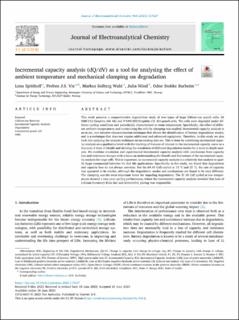| dc.contributor.author | Spitthoff, Lena | |
| dc.contributor.author | Vie, Preben Joakim Svela | |
| dc.contributor.author | Wahl, Markus Solberg | |
| dc.contributor.author | Wind, Julia | |
| dc.contributor.author | Burheim, Odne Stokke | |
| dc.date.accessioned | 2023-09-08T08:49:16Z | |
| dc.date.available | 2023-09-08T08:49:16Z | |
| dc.date.created | 2023-08-17T10:19:29Z | |
| dc.date.issued | 2023 | |
| dc.identifier.citation | Journal of Electroanalytical Chemistry. 2023, 944 . | en_US |
| dc.identifier.issn | 1572-6657 | |
| dc.identifier.uri | https://hdl.handle.net/11250/3088170 | |
| dc.description.abstract | This work presents a comprehensive degradation study of two types of large lithium-ion pouch cells; 26 NMC532/Graphite (64 Ah) and 9 NMC433/Graphite (31 Ah) pouch cells. The cells were degraded under different cycling conditions and periodically characterized at room temperature. Specifically, the effect of different ambient temperatures and constraining the cells by clamping was studied. Incremental capacity analysis is an in situ, non-invasive characterization technique that allows the identification of battery degradation modes, and is a technique that does not require additional and advanced equipment. Therefore, in this study we also look into applying the analysis technique on an existing data set. This is done by combining incremental capacity analysis on a qualitative level with the tracking of features of interest in the incremental capacity curve as a function of State of Health and utilizing the simulation of different degradation modes for a more in-depth analysis. We combine simulation and experimental incremental capacity analysis with conclusions from capacity loss and resistance changes with a focus on understanding the benefit and limitations of the incremental capacity analysis for large cells. This is important, as incremental capacity analysis is a relatively fast analysis to qualify large commercial batteries for 2nd life applications. Specifically in this study, we found that degradation and capacity loss do not always correlate. For the 64 Ah Cells cycled at 15 °C and 25 °C, the rate of capacity loss appeared to be similar, although the degradation modes and mechanisms are found to be very different. The clamping was the most important factor for impeding degradation. The 31 Ah Cell cycled at low temperatures showed a very poor cycling performance, where the incremental capacity analysis revealed that Loss of Lithium Inventory from fast and irreversible plating was responsible. | en_US |
| dc.language.iso | eng | en_US |
| dc.publisher | Elsevier | en_US |
| dc.rights | Navngivelse 4.0 Internasjonal | * |
| dc.rights.uri | http://creativecommons.org/licenses/by/4.0/deed.no | * |
| dc.title | Incremental capacity analysis (dQ/dV) as a tool for analysing the effect of ambient temperature and mechanical clamping on degradation | en_US |
| dc.title.alternative | Incremental capacity analysis (dQ/dV) as a tool for analysing the effect of ambient temperature and mechanical clamping on degradation | en_US |
| dc.type | Peer reviewed | en_US |
| dc.type | Journal article | en_US |
| dc.description.version | publishedVersion | en_US |
| dc.source.pagenumber | 15 | en_US |
| dc.source.volume | 944 | en_US |
| dc.source.journal | Journal of Electroanalytical Chemistry | en_US |
| dc.identifier.doi | 10.1016/j.jelechem.2023.117627 | |
| dc.identifier.cristin | 2167610 | |
| dc.relation.project | Norges forskningsråd: 281005 | en_US |
| dc.relation.project | Norges forskningsråd: 304213 | en_US |
| cristin.ispublished | true | |
| cristin.fulltext | original | |
| cristin.qualitycode | 1 | |

